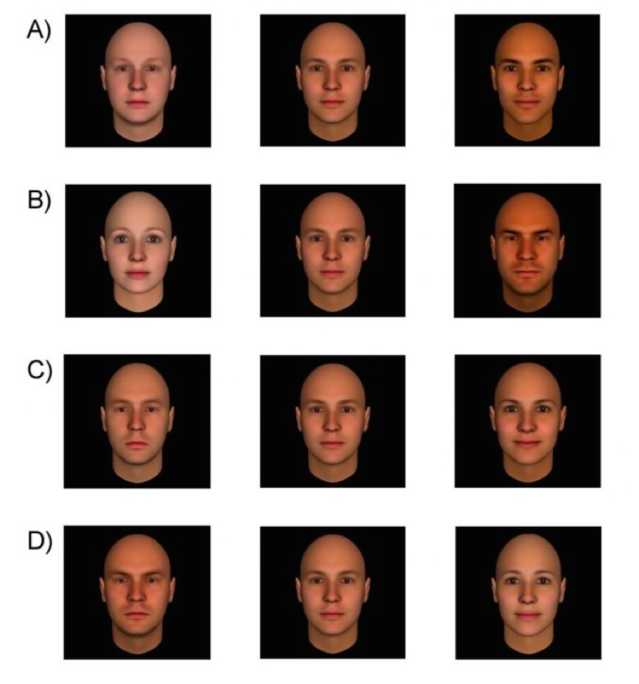Personality
Why It's Surprisingly Easy to See People's Personalities in Their Faces
Personality may be a result of how we treat each other.
Posted September 23, 2017 Reviewed by Jessica Schrader

Are we generally good at judging people's personality? Can we tell by just looking (or listening) whether a person is confident, gregarious, shy, responsible, calm, or attention-seeking?
Recent studies in psychology suggest that we can. Even when we only get a chance to look at a person for a few seconds—also known as a thin-slicing—our judgment of personality is fairly reliable. Although we make quick judgments about personality on the basis of things like facial expression, posture, clothing, and attractiveness, we are generally at least somewhat accurate about initial impressions.
Naumann et al. (2009) carried out a study in which research participants were exposed to full-posture photographs in two conditions—one in which the photographed subjects had a neutral posture and facial expression (standardized condition), and another in which facial expression and posture were spontaneous (spontaneous condition).
The personalities of the people in the photographs were identified through self-reporting and reporting by acquaintances. Accuracy was determined on the basis of a comparison to self-reported personality tests, and significant accuracy was calculated on the basis of results found in other studies of accuracy in thin-slicing conditions.
The researchers found that in the standardized condition, the research participants were accurate for extraversion, self-esteem, and religiosity. In the spontaneous condition, participants perceived a majority of the traits with a significant degree of accuracy.
What is particularly impressive about this is that there was no face-to-face interaction with the people in the photographs, and hence only some degree of nonverbal cues.
One reason for the accuracy of thin-slicing observations likely hinges on the rich information conveyed by physical appearance and the fact that this information reliably tracks people’s personality traits. Type of clothing, hairstyle, and personal grooming all convey information about people’s conscientiousness (Albright et al., 1988; Borkenau & Liebler, 1992), and facial expression and posture convey information about extraversion (Kenny et al., 1992).
A lot of this information is conveyed even in still photographs, because expressive behavior often leaves marks on people’s faces, such as laugh or frown lines (Malatesta, et al., 1987). Neumann et al. (2009), for example, found that in still photographs, the most valid cues of extraversion were having an energetic stance, looking stylish and healthy, and smiling.
The accuracy of personality judgments is likely to increase in conditions that resemble real life, such as those that involve active face-to-face interaction. Still photographs provide only visual information. Active face-to-face interaction typically provides us with auditory cues (e.g., pace of speech, conversational meaning, and discourse markers), tactile cues (e.g., the firmness of a handshake), and olfactory cues (e.g., a scent of perfume or a smell of unwashed hair).
An important question here, though, is why appearances of personality track reality fairly well. It is unsurprising that personality traits can leave marks on people’s faces, postures, level of grooming, and choice of hairstyle and clothing. But many other personality markers could not plausibly be the result of personality. For example, prominent cheekbones and high eyebrows have been found to be an indicator of trustworthiness (Olivola et al. 2014). Yet the shape of cheekbones and height of eyebrows presumably are primarily genetically determined (and hence not a mark of a certain kind of behavior).

How then do we explain the fairly high accuracy of appearances of personality?
I think the most plausible explanation is that the causal relation is reversed: Trustworthiness does not cause prominent cheekbones and high eyebrows. Rather, features indicating trustworthiness may well be shaping people’s personality in childhood, adolescence, and young adulthood. For example, a person who is born with prominent cheekbones and high eyebrows may be signaling trustworthiness from a young age. This, in turn, may lead us to treat the child as trustworthy. Other things being equal, this may encourage him or her to become trustworthy.
If indeed our facial and bodily features shape people's judgments of our personality, and their judgments alter our personality during childhood and adolescence, then personality is in fact much more fluent and changeable that it may at first seem, but in a rather negative way: Our biases can shape what kind of person a child grows up to be.
Facebook image: Iryna Inshyna/Shutterstock
References
Albright, L., Kenny, D. A., & Malloy, T. E. (1988). Consensus in personality judgments at zero acquaintance. Journal of Personality and Social Psychology, 55(3), 387–395.
Borkenau, P., & Liebler, A. (1992). Trait inferences: Sources of validity at zero acquaintance. Journal of Personality and Social Psychology, 62(4), 645–657.
Kenny, D. A., Horner, C., Kashy, D. A., & Chu, L. (1992). “Consensus at Zero-Acquaintance: Replication, Behavioral Cues, and Stability,” Journal of Personality and Social Psychology, 62, 88-97.
Malatesta, C. Z., Fiore, M. J., & Messina, J. J. (1987). “Affect, Personality, and Facial Expression Characteristics of Older People,” Psychology and Aging, 2, 64-69.
Naumann, L. P., Vazire, S., Rentfrow, P. J., & Gosling, S. D. (2009). “Personality Judgments Based on Physical Appearance,” Personality and Social Psychology Bulletin, 35, 1661-1671.
Olivola CY, Funk F, Todorov A. (2014). “Social Attributions from Faces Bias Human Choices,” Trends in Cognitive Sciences. DOI: http://dx.doi.org/10.1016/j.tics.2014.09.007.



